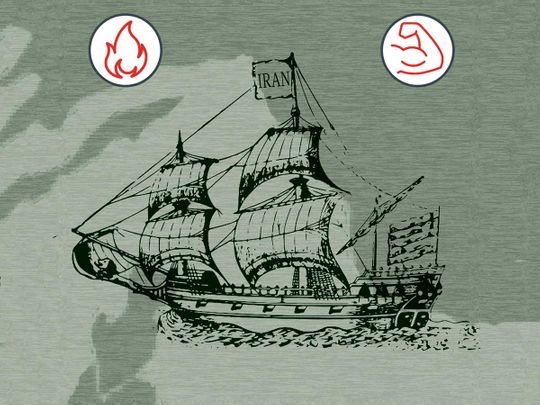
The formidable firepower at the disposal of a Royal Navy warship can often seem inadequate when dealing with the more rudimentary tactics employed by Iran’s Revolutionary Guard in the contested waters of the Arabian Gulf.
On paper, a Type 23 frigate such as HMS Montrose, the Navy warship currently escorting British-registered tankers through the Strait of Hormuz, has the ability to detect and destroy enemy ships and planes from a range of many miles.
Yet when it comes to dealing with swarms of fast patrol boats operating within just a few hundred yards, and equipped with little more than machine guns and rocket-propelled grenades, protecting one of the world’s most important shipping lanes becomes immeasurably harder.
At this time of year in the Gulf, the intense humidity generated by blistering heat reduces visibility on the warship’s bridge to a bare minimum. The ship’s sophisticated technology can identify any craft operating in its vicinity, but in the crowded waters of the Gulf, where small armadas of traditional wooden dhows ply their trade, it is vital that visual contact is made before any action is taken against a target. Thus, during the few days I spent patrolling the Gulf on board a Navy warship, the crew was reduced to peering into the intense haze through binoculars to identify enemy activity.
The ayatollahs always want to have the ability to deny their involvement in hostile acts, which is why they are such generous sponsors of numerous terrorist groups.
This was back in 1987 when, at the height of the Iran-Iraq war, the Royal Navy joined an international task force to protect shipping in the Gulf that was vulnerable to attack by Iran’s Revolutionary Guard. And while the war-fighting capabilities of warships has changed considerably since I joined HMS Broadsword, a 4,400-ton Type 22 frigate, on one of the Navy’s Armilla patrols, the challenge of dealing with the unpredictable and relatively primitive naval threat posed by the Guard’s fast patrol boats remains very much the same.
At a time when tensions in the Gulf are already high as a result of Tehran’s stand-off with Washington, any slight misjudgement on the part of the crew of HMS Montrose recently as they prevented Iranian gunboats from harassing the BP-registered tanker British Heritage could have led to a serious escalation in the crisis. And this, of course, is just what the Iranians would like to see: Western warships blamed for accidental attacks on civilian shipping.
Iran has no navy of its own to speak of — most of the British-built ships from the Shah’s era are unfit for modern warfare. And even if they were of some use, conducting conventional military operations does not suit the Iranian regime’s modus operandi. The ayatollahs always want to have the ability to deny their involvement in hostile acts, which is why they are such generous sponsors of numerous terrorist groups.
Moreover, when the Iranian economy is suffering badly from US sanctions, Tehran is desperate not to give Washington another pretext for increasing further the economic pain in a country where the rial, the national currency, has plunged in value by more than 60 per cent in the past year and inflation is up by 40 per cent.
So disrupting shipping in the Gulf without being blamed for it is really about the only viable option that is available to the ayatollahs.
— The Telegraph Group Limited, London 2019
Con Coughlin is the Daily Telegraph’s defence editor and chief foreign affairs columnist.








